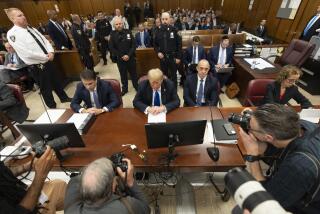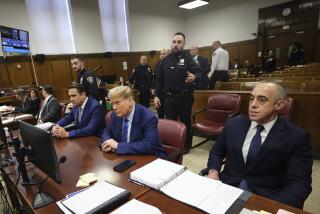Andersen Jury Comes to Deadlock
- Share via
HOUSTON — The jury deliberating in the Arthur Andersen obstruction-of-justice trial said Wednesday that it was deadlocked, raising the prospect of a mistrial unless the panel can reach a unanimous decision through further discussions.
U.S. District Judge Melinda Harmon ordered the panel of nine men and three women to continue deliberations today in hopes of avoiding a hung jury.
“We are not able to reach a unanimous decision,” the jury said in a note to the judge after more than 56 hours of deliberations.
Harmon gave jurors the so-called Allen charge, based on the U.S. Supreme Court decision in Allen vs. the United States, telling jurors that they have the best understanding of the case and that there is no reason to believe the evidence would be tried “better or more exhaustively” in the event of a retrial.
“I’m going to ask you to continue deliberations,” Harmon said. “This is an important case. The trial has been expensive in time, effort and money, to both the defense and the prosecution. If you should fail to agree on a verdict, the case is left open and must be tried again.”
Over the objections of the defense, however, Harmon did not include a sentence instructing the jury that “if the evidence in the case fails to establish guilt beyond a reasonable doubt, the accused should have your unanimous verdict of not guilty.” Harmon said that instruction did not appear relevant and told the defense, “If I’m wrong, you [can] get me reversed.”
Jurors must reach a unanimous verdict to convict or acquit the firm.
Prosecutors declined to comment on the deadlock. In the event of a hung jury, however, Justice Department officials indicated this week they would seek a retrial.
One recent study of the use of the Allen charge in federal cases found that it often results in a verdict, but the decision is typically appealed. In cases in which the jury voted to convict after receiving the Allen instruction, the study found, higher courts reversed the verdict about 24% of the time.
Outside the courtroom, Hardin expressed mixed feelings about the situation, noting that the divided panel indicates that the government has not been able to convince the panel--at least thus far--that Andersen is guilty.
“This jury, unlike everyone else, listened to the facts,” Hardin said. “The problem is, once you have half a loaf, you want the whole loaf.”
Andersen was charged with a single count of obstruction of justice for shredding documents related to its audit of Enron Corp., the energy trader that filed the biggest bankruptcy in U.S. history Dec. 2.
A hung jury would be a blow to the case against Enron, one legal expert said, because it would sap the government of valuable time and resources. Instead of being freed to concentrate on Enron, certain prosecutors on the Justice Department’s Enron task force would have to gear up for an Andersen retrial.
Moreover, potential defendants could interpret a mistrial as a sign of prosecutors’ weakness, opt to forgo plea bargaining and in essence dare the Justice Department to try to convict them.
“It would really slow down the momentum,” said John J. Fahy, a former federal prosecutor in New Jersey and now a partner in Newark, N.J., law firm Reed Smith. “They indicted Andersen fast. They wanted to keep the focus on Enron. It would be a setback.”
Failure to win a conviction in the current trial could result in criticism against Justice Department officials, particularly criminal division chief Michael Chertoff, for diverting resources on Andersen when Enron is seen as the chief target.
Another problem for the government is that Andersen’s lawyers, having seen and evaluated the prosecution’s witnesses, would be able to put up a stiffer defense the second time around.
“No prosecutor ever wants a retrial,” Fahy said.
Still, there is little likelihood that the government would drop the charges because it would represent too great a loss of face in such a high-profile case, he added.
In some cases after a mistrial, the opposing sides will try to reach a settlement. But Fahy said Andersen would have little to gain from a settlement because the company is rapidly disintegrating. And Hardin said Wednesday that the company will not cut a deal with the government.
Going into the trial, the government was widely seen to have a huge advantage. David B. Duncan, who led the Enron audit team out of Andersen’s Houston office, pleaded guilty to obstruction of justice April 9 and agreed to cooperate as the prosecution’s star witness.
Moreover, prosecutors consider obstruction to be one of the easiest white-collar offenses to prove, in part because it doesn’t usually require jurors to understand complex financial details.
The jury impasse “really points out the vagaries of the justice system,” said Stephen Meagher, a former federal prosecutor now in private practice in San Francisco. “It’s never a no-risk proposition to go to trial.”
In the course of the trial, Justice Department attorneys argued that Andersen executives feared regulatory sanctions for their Enron work in part because the firm already had run afoul of the Securities and Exchange Commission for its audits of Waste Management Inc. and Sunbeam Corp.
Prosecutors said the firm’s legal department then devised a way to shield Andersen from regulators and investor lawsuits by urging the Enron audit team to comply with the firm’s little-invoked document-retention policy, which called for disposing of drafts, copies and other files deemed unnecessary once auditors reached their final accounting decisions.
Andersen countered by saying its executives lacked criminal intent, and destroyed files under legal business practices. The defense dismissed the idea of a concerted effort to destroy documents, pointing out again and again that the papers introduced as evidence by government prosecutors had been saved--and not destroyed--by Andersen employees.
Although a conviction probably would result in SEC action to bar Andersen from auditing public companies, few industry observers see the company surviving under any scenario, even an acquittal.
Andersen already has lost its biggest clients, and key partners and offices within the company have cut deals to move their practices to rival accounting firms. Industry power is expected to consolidate in a Big Four of major firms--Deloitte & Touche, PricewaterhouseCoopers, Ernst & Young and KPMG.
*
Times staff writers Thomas S. Mulligan in New York and Jerry Hirsch in Los Angeles contributed to this report.
More to Read
Sign up for Essential California
The most important California stories and recommendations in your inbox every morning.
You may occasionally receive promotional content from the Los Angeles Times.













